Negative Influence of Continuous Wave Technique on Apical
Introduction
Apical periodontitis is a biofilm-related infection, and one of the primary goals of treatment is to kill or remove microbes from the root canal system1. However, complete elimination is difficult in anatomically complex areas of the root canal system, which are often inaccessible to instruments2. Therefore, instrumentation must be combined with adequate irrigation to complete the cleaning process and decrease the microbial load within the root canal system3. However, curvatures, which are common in root canals4, can reduce the cleaning efficacy of various irrigation techniques5,6. Two important factors should be considered during irrigation: (a) whether the system can deliver irrigant to the entire root canal system, particularly the apical third, and (b) whether it is capable of debriding areas not accessible by mechanical instrumentation, such as lateral canals and isthmuses3,7,8. Consequently, it is important to investigate whether irrigant systems can introduce irrigant into the apical third of the root canal and into lateral canals.
The most common irrigation method is the conventional type using an irrigating cannula with the front extremity or side coupled to a syringe. However, this method is limited for cleaning the apical portion and areas such as isthmuses and lateral canals3,9.
Passive ultrasonic irrigation (PUI), which uses ultrasound to induce cavitation and acoustic waves, is also used to agitate irrigating solutions, thereby improving irrigant properties and cleaning ability in anatomically complex areas10,11. Nevertheless, this approach may result in uncontrolled removal of dentin in straight root canals12.
To address the limitations of these techniques, several modifications have been proposed. Gutarts et al.13 developed continuous ultrasonic irrigation (CUI) using an ultrasonically activated needle placed inside the root canal with a flow of NaOCl, enabling continuous replenishment. Using this method, in vivo studies have shown high cleaning efficiency in areas inaccessible via instrumentation7,14. In addition, an in vitro study showed improved penetration of irrigants in lateral canals compared with PUI15. However, this approach can transport irrigant beyond the distance at which the instrument acts, leading to possible extrusion of sodium hypochlorite (NaOCl) into the periapical tissues16. On the other hand, various studies have supported the safety of negative-pressure cleaning systems compared to irrigation with a syringe or ultrasonic irrigation17,18.
In this study, we designed a device for continuous apical negative-pressure ultrasonic irrigation (CANUI)19, which combines characteristics of the negative-pressure cleaning systems (to avoid apical extrusion and transport irrigant to the working length) and continuous ultrasonic irrigation systems (to penetrate irrigant into irregularities of the root canal system; Fig. 1). The device consists of a body connected to an ultrasonic unit [Suprasson P5 Booster (Satelec, Acteón Group)] through the lower thread (Fig. 2). From the top this body emerges a steel cannula (that has a pointed diameter of 0.75 mm) and a micro-cannula (0.3 mm) inserted into a cannula (Figs. 3, 4). This micro-cannula is constructed using nickel–titanium and can adapt to the anatomy of curved root canals.
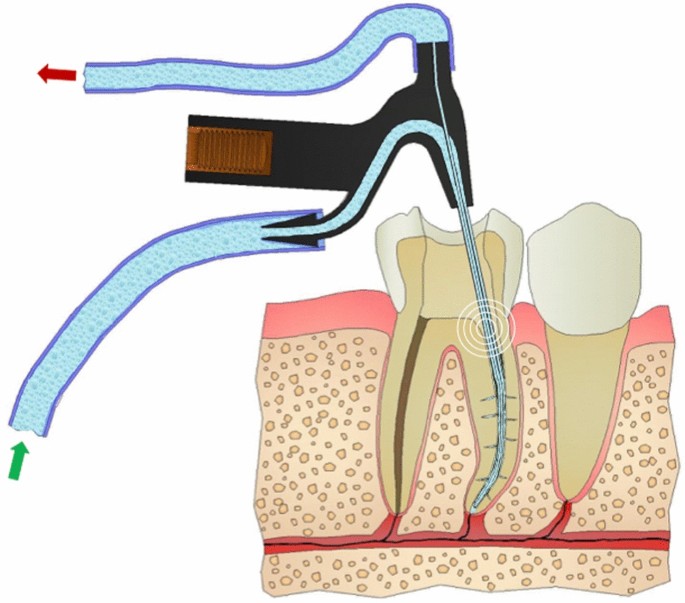
Representation of CANUI design and mode of operation.
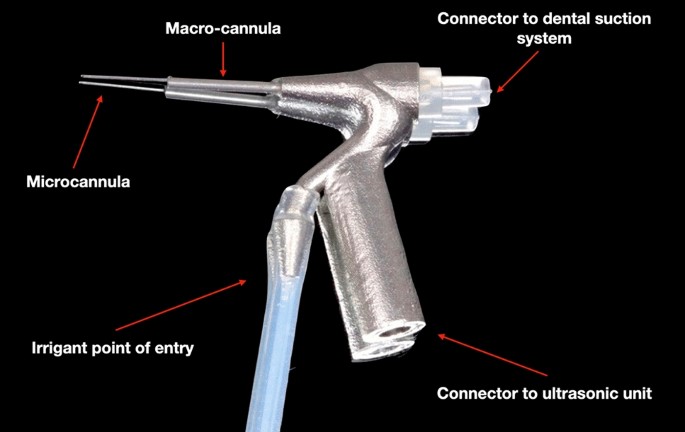
Prototype of CANUI.
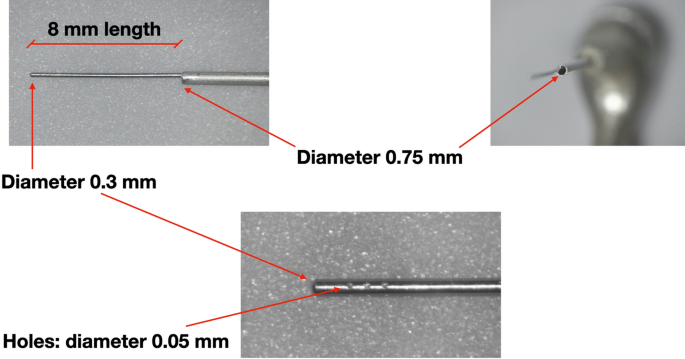
Micro and macro-cannula design and measurements.

Images showing the assembly of the device (introduction of the micro-cannula into the body and macro-cannula).
The purpose of this study was to compare the effects of three irrigation systems (PPI, PUI, and CANUI) on irrigant delivery into the apical third of the root canal and into simulated lateral canals in cleared extracted teeth in straight and curved root canals.
Methodology
Ethics declarations
This research was carried out in accordance with relevant guidelines and regulations, followed after ethics committee approval (Comité de Ética de Investigación de Galicia, 2016/269). All biological samples were included after obtaining the informed constent from all subjects.
Methods
120 extracted human single-root teeth with fully formed apices (maxillary central with straight canal and morphology) that had not undergone prior endodontic treatment were selected of these, 60 teeth were straight, and 60 had root curvatures of 20–30º, as determined using the Schneider method20. After debriding and complete cleaning of the root surface, samples were immersed in a 5.25% NaOCl (Dentaflux, Madrid, Spain) for 30 min and then stored in saline solution until preparation. The presence of a single canal was verified radiographically and by direct exploration. The same operator performed all experimental procedures. Each specimen was sectioned to a working length of 16 mm. The working length was established under a microscope (M525 F40; Leica, Heerbrugg, Switzerland) at 10× magnification with the tip of #10K-file (Dentsply Maillefer, Ballaigues, Switzerland) visible at the apical foramen. Each root canal was pre-flared using K-Flexofiles (Dentsply Maillefer, Ballaigues, Switzerland) up to #20 and then shaped using ProTaper Next X4 (Dentsply Maillefer, Ballaigues, Switzerland). Irrigation was performed with a 30-G needle (ProRinse; Dentsply Tulsa Dental Specialties, Tulsa, OK) using 3 mL of 5% NaOCl after each file. The irrigation needles were introduced passively up to 2 mm from the working length, and the rate of delivery was fixed at 3 mL/min. The total irrigation time was 10 min/specimen. After instrumentation, all teeth were rinsed for 3 min with 3 mL 17% EDTA (Canal Pro, Coltene Whaledent, Altstätten, Switzerland) followed by a 3-min final rinse with 5% NaOCl. After drying with paper points, the roots were inspected under the microscope at 10X magnification to verify the absence of cracks and to confirm canal cleanliness.
After completing the shaping procedures, teeth were cleared using the modified technique described by Robertson and Leeb21 and prepared following the protocol described by de Gregorio et al.3. Briefly, teeth were submerged in 5% nitric acid for 36 h, and the solution was renewed every 8 h. Once decalcified, samples were cleared with tap water for 3 min, and lateral canals were created by inserting a 06 C+ file (Dentsply Maillefer, Ballaigues, Switzerland) from the buccal to the lingual wall at 2, 4, and 6 mm from the working length perpendicular to the external surface. Samples were dehydrated in ascending grades of ethyl alcohol and submerged in 99.9% methyl salicylate for clearing and rehardening of dental tissues, as described by de Gregorio et al.3. A total of 360 simulated lateral canals were created (6 canals/tooth, 2 lateral canals at each level) for straight canals and 360 for curved canals.
To mimic the clinical situation, a closed system was created by coating each root with soft modeling wax (Cera Reus SA, Reus, Spain). This coating sealed the apical foramen and lateral canals at all three levels. During this procedure, a gutta-percha point was introduced into the canal to the working length to prevent penetration of wax into the canal space.
Contrast solution
A contrast solution containing 5% NaOCl (80%) and 20% Chinese ink (Sanford Rotring GmbH, Hamburg, Germany) was prepared and delivered to the prepared root canals.
Experimental groups
Irrigation was performed in the PPI and PUI groups as described by de Gregorio et al.3, with minor modifications. Briefly, irrigation was performed in the CANUI group by introducing the micro-cannula to the working length (Fig. 5). Irrigation time was the same for all three groups (1 min). All procedures were recorded under a dental operating microscope. Details of the irrigation sequences are presented later.

X-rays showing the device in the root canal and the micro-cannula reaching working length (showing both decoronated and non-decoronated roots).
Group 1 (n = 20): Positive pressure (control). Teeth in group 1 were irrigated with PPI (1 min) using a 30-G ProRinse needle and a syringe to 2 mm from the working length. A total volume of 6 mL of contrast solution was delivered. The solution was not dynamically activated in this group.
Group 2 (n = 20): PUI. A total volume of 2 mL of contrast solution was delivered into the teeth in group 2 using a 30-G ProRinse needle, and the solution was left in the root canals. Ultrasonic activation was performed with an ISO15 ESI file (EMS, Nyon, Switzerland) mounted on an ultrasonic unit. The file was passively inserted to 1 mm from the working length and activated using a power setting of 4, as recommended by the manufacturer. The procedure was repeated three times, for a total volume of 6 mL of contrast solution and a total activation time of 1 min for each tooth.
Group 3 (n = 20): CANUI. Continuous apical negative ultrasonic irrigation was performed using prototypes (Figs. 2, 3, 4) of the device mounted on a Suprasson P5 Booster ultrasonic unit. A 10-mL syringe containing contrast solution was attached to the luer-lock connection on the UI needle and inserted to the working length with the microcannula (Fig. 5). Then, the device was activated with the power set to level 6, and the solution was delivered, maintaining a continuous irrigation flow of 6 mL/min. The total activation time was 1 min; a total volume of 6 mL of contrast solution was delivered.
Evaluation criteria
The criteria described by de Gregorio et al.3 were used in this study. Samples were evaluated by direct observation of images recorded under the dental operating microscope (Figs. 6, 7). The orientation of all samples was standardized in relation to the recording microscope to produce similar images for all groups.
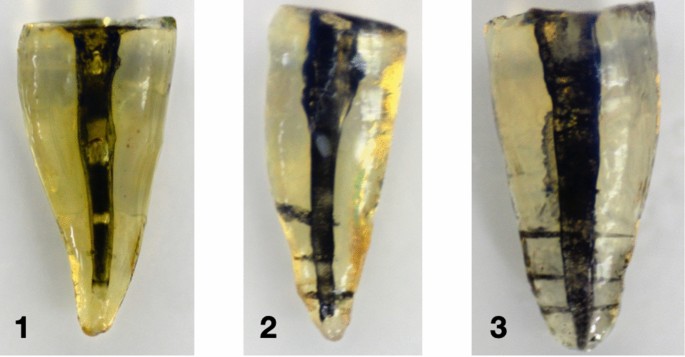
Representative images of straight canals. 1 PPI, 2 PUI, 3 CANUI.
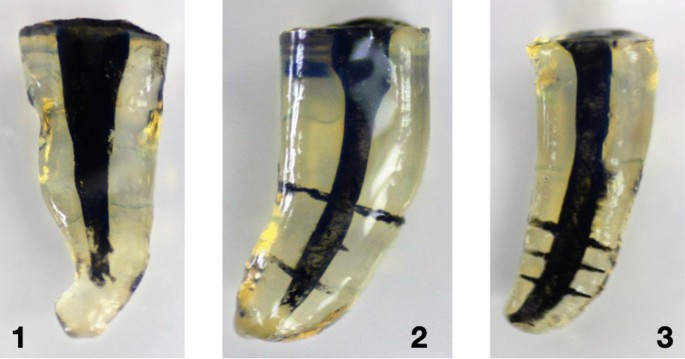
Representative images of curved canals. 1 PPI, 2 PUI, 3 CANUI.
The penetration of contrast solution into the simulated lateral canals was scored by counting the number of lateral canals (0–2) penetrated to at least 50% of the total length (Fig. 8). The outcome was assessed in each tooth at the three working lengths (2, 4, and 6 mm). One trained evaluator, who was blinded to the group assignment of each sample, scored all samples.
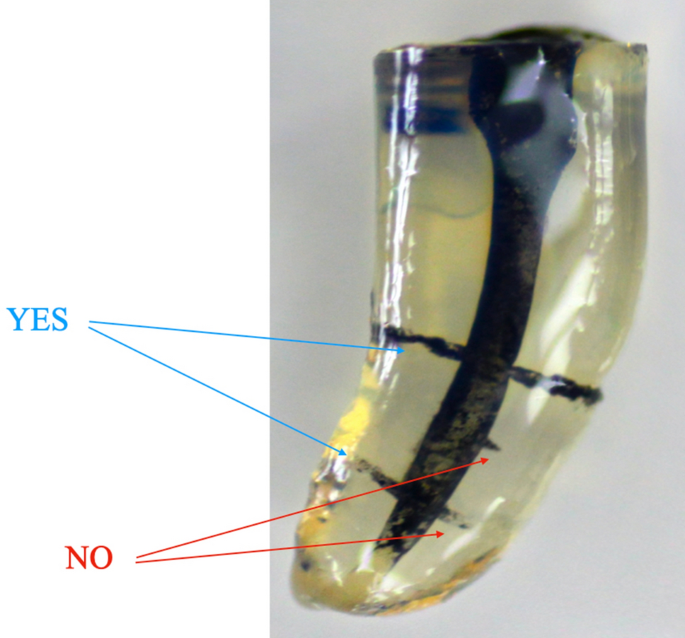
Evaluation criteria: Contrast solution penetrated to at least 50% of the total length.
Statistical analysis
The Mann–Whitney U-test was used to analyze and compare irrigant penetration to the working length and into lateral canals. A comparison between straight and curved canals of root canals was made using the same test. P-values of 0.05 were considered statistically significant.
Results
The flow of irrigant into lateral canals and to the working length was analyzed for all samples (n = 20) in each group in straight and curved canals.
Reaching the working length
Straight canals: In the first group (PPI, control), the contrast solution did not reach the working length in any sample (0%). The contrast solution reached the working length in 65% of samples in group 2 (PUI) and 100% of samples in group 3 (CANUI). Penetration of the irrigant to the working length was significantly different among the three groups (Table 1).
Curved canals: Penetration was complete in 0% of group 1, 35% of group 2, and 100% of group 3 (CANUI). Penetration of the irrigant to the working length differed significantly among the three groups (Table 2).
When we compared curved and straight canals, we found no significant difference, although the penetration was greater in straight canals for PUI.
Penetration into lateral canals
Straight canals: Overall penetration into lateral canals was 0% for group 1 (PPI), 33.33% for group 2 (PUI), and 86.67% for group 3 (CANUI) (Figs. 6, 9). These values differed significantly among the groups (P < 0.001). These results were confirmed in separate analyses of the three levels (Table 1).
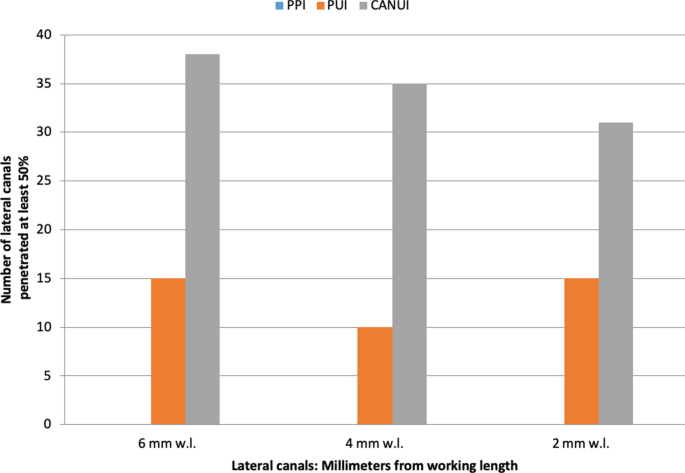
Graphical representation of straight root canals penetrated by the irrigation solution.
Curved canals: Overall penetration into lateral canals was 0% for group 1 (PPI), 35.83% for group 2 (PUI), and 81.67% for group 3 (CANUI) (Figs. 7, 10). These values differed significantly among the three groups (P < 0.001). These results were confirmed in separate analyses for the three levels (Table 2).
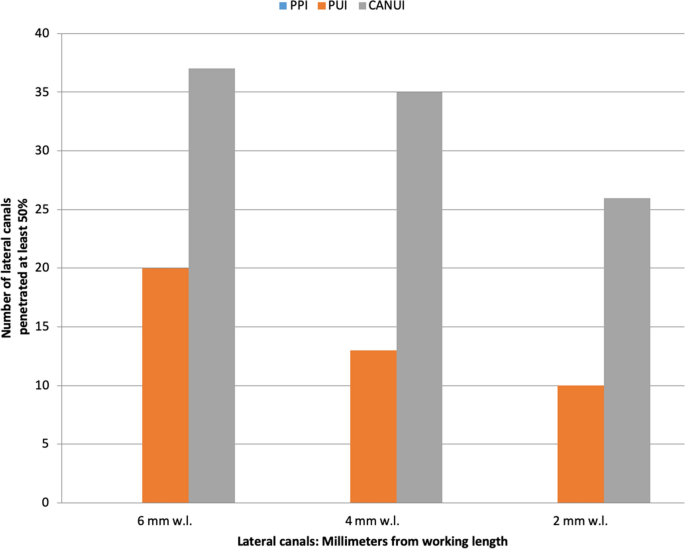
Graphical representation of curved root canals penetrated by the irrigation solution.
There was no significant difference between straight and curved canals in terms of PUI penetration into the lateral canals; similar results were found in the CUI group.
Discussion
The purpose of chemo–mechanical root canal preparation is to clean, disinfect and create a space in the root canal system for the subsequent filling procedure22. The goal is to clean the canal system before sealing to prevent the microorganism survival, reinfection, and subsequent inflammatory host reactions23. Lack of healing is often attributed to persistent intra-radicular infection in previously uninstrumented canals, dentinal tubules, or in the complex irregularities of the root canal system24,25. To avoid infection and develop a safe device, a new device, called CANUI, was designed that integrates advantages of continuous ultrasonic irrigation (CUI) and apical negative pressure (ANP). This system allows simultaneous continuous irrigant delivery and continuous ultrasonic activation, which is possible because the device is connected directly to the ultrasound unit, provides continuous replenishment of the solution (crucial for organic tissue dissolution26), and is activated without direct contact between the ultrasonic file and solution.
Based on a previous report, it is important to standardize specimens to avoid anatomic biases that may interfere with the outcomes. Therefore, despite natural variations in teeth morphology, attempts were made to ensure comparability of the groups in root canal morphology. In this in vitro investigation, we compared the ability of two ultrasonic irrigation techniques (PUI and CANUI) and one traditional technique (PPI) to deliver a contrast dye-containing irrigating solution into the apical third of straight and curved root canals and into artificially created lateral canals in cleared extracted teeth. To reproduce the clinical situation, we used an in vitro closed-end canal design that closely replicates in vivo scenarios27,28, in which the apical foramen is enclosed in alveolar bone and the periodontal ligament7,13. Clinically, this design forces the irrigants to exit the canal coronally rather than apically or laterally3. As shown in previous reports3,15, irrigation with PPI did not reach the working length or penetrate lateral canals. This may be due to the presence of an apical vapor lock created by the organic decomposition of NaOCl into a bubble of carbon dioxide and ammonium29. Furthermore, PPI does not have enough force to penetrate lateral canals in either straight or curved canals.
We also compared two ultrasonic techniques (PUI and CANUI) with each other and with PPI. Both ultrasonic techniques produced adequate irrigant penetration into the apical third of the root canal, but CANUI reached the apical third in all cases, demonstrating significantly greater success than the other groups. This may be due to the apical force of suction of ANP, as demonstrated by de Gregorio et al.3. This can be explained by the design of the microcannula, which eliminates vapor lock and allows for apical exchange of irrigants. On the other hand, the efficacy of PUI depends on penetration of the ultrasonic file to 1 to 2 mm from the working length, and the volume of activated solution is limited30. We found no statistical difference between straight and curved canals.
Finally, it was compared the penetration of irrigant into the simulated lateral canals; significant differences were observed among the three groups (p < 0.05). Previous studies have observed greater efficacy of PUI when compared syringe and needle (PPI) and other techniques31,32. The effectiveness of this method for activating irrigants may be due to the production of acoustic microwaves and cavitation33. However, some studies have contested its efficacy in curved canals7,34, possibly because the ultrasonic tip should not act freely inside the canal space and may bind to the walls and interfere with acoustic streaming and cavitation, resulting in a poorer debridement35. In our study, there was no significant difference between straight and curved canals in PUI groups, although we observed increased penetration into the apical third of the straight canals. Moreover, complications such as ledge formation, uncontrolled cutting of the root canal walls, and perforations have been reported using PUI35. In the present study, we applied ESI instruments made of nickel titanium for increased flexibility, which may improve the quality of the instrument compared to steel, to avoid these problems. In this investigation, we didn´t observe these complications. On the other hand, CANUI groups showed improved penetration into lateral canals compared with PUI in curved and straight canals. This may be due to the continuous exchange of solution and the optimized activation of the solution as it passes through the ultrasonically energized needle, enhanced by the force of the ANP.
Limitations of this study include the lack of similar studies for comparison. It can be concluded that under the conditions of this study, CANUI improves penetration into the lateral canals and up to the working length of the cleared teeth in straight and curved roots.
References
-
Sjogren, U., Figdor, D., Persson, S. & Sundqvist, G. Influence of infection at the time of root filling on the outcome of endodontic treatment of teeth with apical periodontitis. Int. Endod. J. 30, 297–306 (1997).
-
Ordinola-Zapata, R. et al. Biofilm removal by 6% sodium hypochlorite activated by different irrigation techniques. Int. Endod. J. 47, 659–666 (2014).
-
de Gregorio, C., Estevez, R., Cisneros, R., Paranjpe, A. & Cohenca, N. Efficacy of different irrigation and activation systems on the penetration of sodium hypochlorite into simulated lateral canals and up to working length: an in vitro study. J. Endod. 36, 1216–1221 (2010).
-
Cunningham, C. & Senia, E. A three-dimensional study of canal curvatures in the mesial roots of mandibular molars. J. Endod. 18, 294–300 (1992).
-
Chenail, B. & Teplitsky, P. Endosonics in curved root canals. J. Endod. 11, 369–374 (1995).
-
Rödig, T., Döllmann, S., Konietschke, F., Drebenstedt, S. & Hülsmann, M. Effectiveness of different irrigant agitation techniques on debris and smear layer removal in curved canals: a scanning electron microscopy study. J. Endod. 36, 1983–1987 (2010).
-
Amato, M., Vanoni-Heineken, I., Hecker, H. & Weiger, R. Curved versus straight root canals: the benefit of activated irrigation techniques on dentin debris removal. Oral. Surg. Oral. Med. Oral. Pathol. Oral. Radiol. Endod. 111, 529–534 (2011).
-
Burleson, A., Nusstein, J., Reader, A. & Beck, M. The in vivo evaluation of hand/rotatory/ultrasound instrumentation in necrotic, human mandibular molars. J. Endod. 33, 782–787 (2007).
-
Siqueira, J. F. Jr., Lima, K. C., Magalhaes, F. A., Lopes, H. P. & de Uzeda, M. Mechanical reduction of the bacterial population in the root canal by three instrumentation techniques. J. Endod. 25, 332–335 (1999).
-
van der Sluis, L. W. et al. Study on the influence of refreshment/activation cycles and irrigants on mechanical cleaning efficiency during ultrasonic activation of the irrigant. J. Endod. 36, 737–740 (2010).
-
Guerreiro-Tanomaru, J. M. et al. Effect of passive ultrasonic irrigation on Enterococcus faecalis from root canals: an ex vivo study. Braz. Dent. J. 26, 342–346 (2015).
-
Boutsioukis, C. & Tzimpoulas, N. Uncontrolled removal of dentin during in vitro ultrasonic irrigant activation. J. Endod. 42, 289–293 (2016).
-
Gutarts, R., Nusstein, J., Reader, A. & Beck, M. In vivo debridement efficacy of ultrasonic irrigation following hand-rotary instrumentation in human mandibular molars. J. Endod. 31, 166–170 (2005).
-
Carver, K., Nusstein, J., Reader, A. & Beck, M. In vivo antibacterial efficacy of ultrasound after hand and rotary instrumentation in human mandibular molars. J. Endod. 33, 1038–1043 (2007).
-
Castelo-Baz, P. et al. In vitro comparison of passive and continuous ultrasonic irrigation in simulated lateral canals of extracted teeth. J. Endod. 38, 688–691 (2012).
-
Hülsmann, M., Rodig, T. & Nordmeyer, S. Complications during root canal irrigation. Endod. Top. 16, 27–63 (2009).
-
Desai, P. & Himel, V. Comparative safety of various intracanal irrigation systems. J. Endod. 35, 545–549 (2009).
-
Fukumoto, Y., Kikuchi, I., Yoshioka, T., Kobayashi, C. & Suda, H. An ex vivo evaluation of a new root canal irrigation technique with intracanal aspiration. Int. Endod. J. 39, 93–99 (2006).
-
Castelo Baz, P. et al. Continuous apical negative-pressure ultrasonic irrigation (CANUI): a new concept for activation irrigants. J. Clin. Exp. Dent. 9, 789–793 (2017).
-
Schneider, S. W. A comparison of root canal preparations in straight and curved canals. Oral. Surg. Oral. Med. Oral. Pathol. 32, 271–275 (1971).
-
Robertson, D. C. & Leeb, I. J. The evaluation of a transparent tooth model system for the evaluation of endodontically filled teeth. J. Endod. 8, 317–321 (1982).
-
Grossman, L. I. Irrigation of root canals. JADA 30, 1915–1917 (1943).
-
Schilder, H. Cleaning and shaping the root canal. Dent. Clin. N. Am. 18, 269–296 (1974).
-
Nair, P. N. On the causes of persistent apical periodontitis: a review. Int. Endod. J. 39, 249–281 (2006).
-
Davis, S. R., Brayton, S. M. & Goldman, M. The morphology of the prepared root canal: a study utilizing injectable silicone. Oral. Surg. Oral. Med. Oral. Pathol. 34, 642–648 (1972).
-
Stojicic, S., Zivkovic, S., Qian, W., Zhang, H. & Haapasalo, M. Tissue dissolution by sodium hypochlorite: effect of concentration, temperature, agitation, and surfactant. J. Endod. 36, 1558–1562 (2010).
-
Migun, N. P. & Shnip, A. I. Model of film flow in a dead-end conic capillary. J. Eng. Phys. Thermophys. 75, 1422–1428 (2002).
-
Usman, N., Baumgartner, J. C. & Marshall, J. G. Influence of instrument size on root canal debridement. J. Endod. 30, 110–112 (2004).
-
Tay, F. R. et al. Effect of vapor lock on root canal debridement by using a side-vented needle for positive-pressure irrigant delivery. J. Endod. 36, 745–750 (2010).
-
Van der Sluis, L., Wu, M. & Wesselink, P. The efficacy of ultrasonic irrigation to remove artificially placed dentine debris from human root canals prepared using instruments of varying taper. Int. Endod. J. 38, 764–768 (2005).
-
Leoni, G. B. et al. Ex vivo evaluation of four final irrigation protocols on the removal of hard-tissue debris from the mesial root canal system of mandibular first molars. Int. Endod. J. 50, 398–406 (2017).
-
Varela, P., Souza, E., de Deus, G., Durán-Sindreu, F. & Mercadé, M. Effectiveness of complementary irrigation routines in debriding pulp tissue from root canals instrumented with a single reciprocating file. Int. Endod. J. 52, 475–483 (2018).
-
Nusstein, J. M. Sonic and ultrasonic irrigation in Endodontic irrigation: chemical disinfection of the root canal system (ed. Basrani, B.) 173–198 (Springer, 2015).
-
Boutsioukis, C., Verhaagen, B., Walmsley, A. D., Versluis, M. & van der Sluis, L. W. Measurement and visualization of file-to-wall contact during ultrasonically activated irrigation in simulated canals. Int. Endod. J. 46, 1046–1055 (2013).
-
Ahmad, M., Pitt Ford, T. R., Crum, L. A. & Walton, A. J. Ultrasonic debridement of root canals: acoustic cavitation and its relevance. Int. Endod. J. 42, 391–398 (2009).
Ackowledgements
The authors report the following potential conflict of interest: The authors create the idea of CANUI and fabricate the prototypes to test it. The authors deny any involvement with any commercial organization with direct financial interest.
Author information
Authors and Affiliations
Contributions
P.C.-B. contributed to the conception and design of study, analysis and interpretation of data, drafting the manuscript and revising the manuscript. F.J.R.-L. contributed to the analysis and interpretation of data and revising the manuscript. M.J.G.-V. contributed to the analysis and interpretation of data and revising the manuscript. R.M.-V. contributed to the design of study, data collection and drafting the manuscript. J.S.-R. contributed to data collection and drafting the manuscript. J.M.-C. contributed to data collection and drafting the manuscript. B.M.B. contributed to the design of study and revising the manuscript.
Corresponding author
Ethics declarations
Competing interests
The authors report the following potential conflict of interest: Pablo Castelo-Baz and Benjamín Martín Biedma created the idea of CANUI and fabricated the prototypes to test it. The authors deny any involvement with any commercial organization with direct financial interest. All other authors have no competing/conflict of interest.
Additional information
Publisher's note
Springer Nature remains neutral with regard to jurisdictional claims in published maps and institutional affiliations.
Rights and permissions
Open Access This article is licensed under a Creative Commons Attribution 4.0 International License, which permits use, sharing, adaptation, distribution and reproduction in any medium or format, as long as you give appropriate credit to the original author(s) and the source, provide a link to the Creative Commons licence, and indicate if changes were made. The images or other third party material in this article are included in the article's Creative Commons licence, unless indicated otherwise in a credit line to the material. If material is not included in the article's Creative Commons licence and your intended use is not permitted by statutory regulation or exceeds the permitted use, you will need to obtain permission directly from the copyright holder. To view a copy of this licence, visit http://creativecommons.org/licenses/by/4.0/.
Reprints and Permissions
About this article
Cite this article
Castelo-Baz, P., Lozano, F.J.R., Ginzo-Villamayor, M.J. et al. Efficacy of continuous apical negative ultrasonic irrigation (CANUI) in penetration of simulated lateral canals in extracted teeth. Sci Rep 11, 10908 (2021). https://doi.org/10.1038/s41598-021-90430-0
-
Received:
-
Accepted:
-
Published:
-
DOI : https://doi.org/10.1038/s41598-021-90430-0
Source: https://www.nature.com/articles/s41598-021-90430-0
0 Response to "Negative Influence of Continuous Wave Technique on Apical"
Postar um comentário